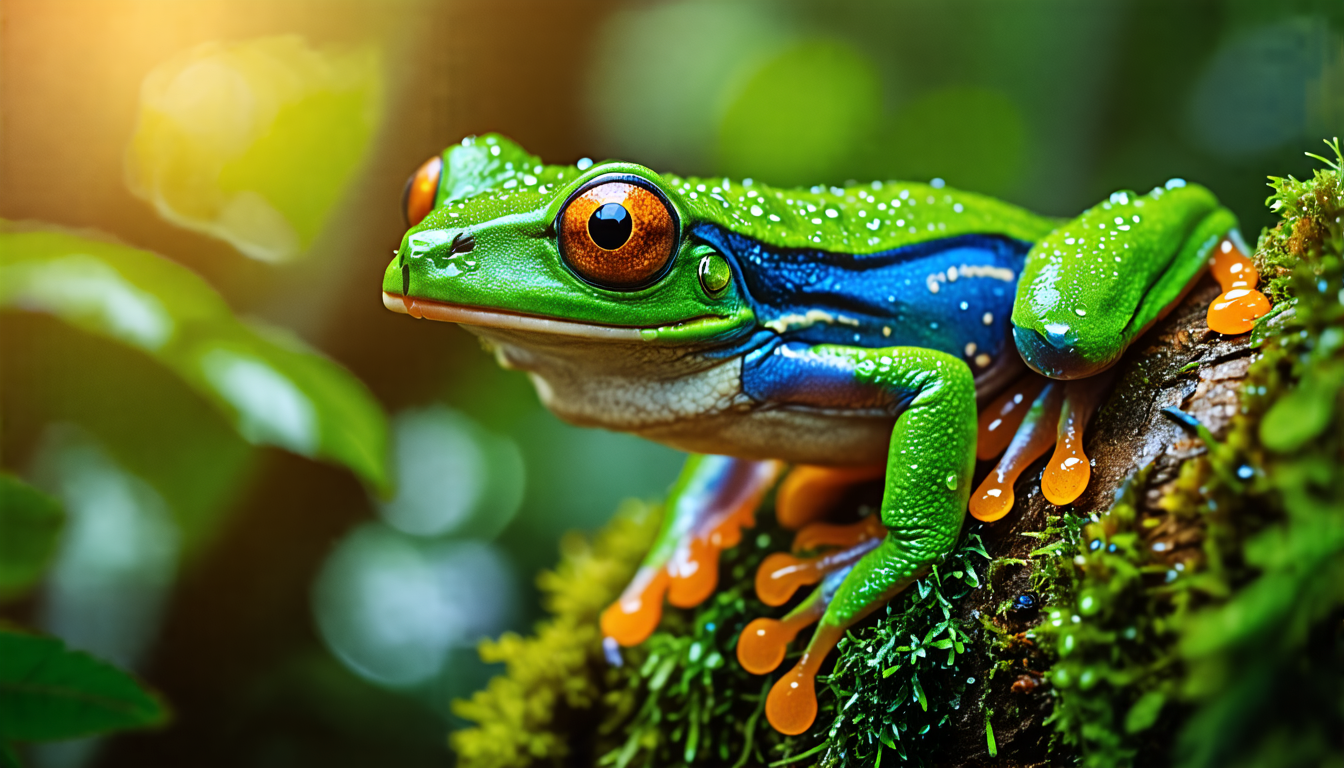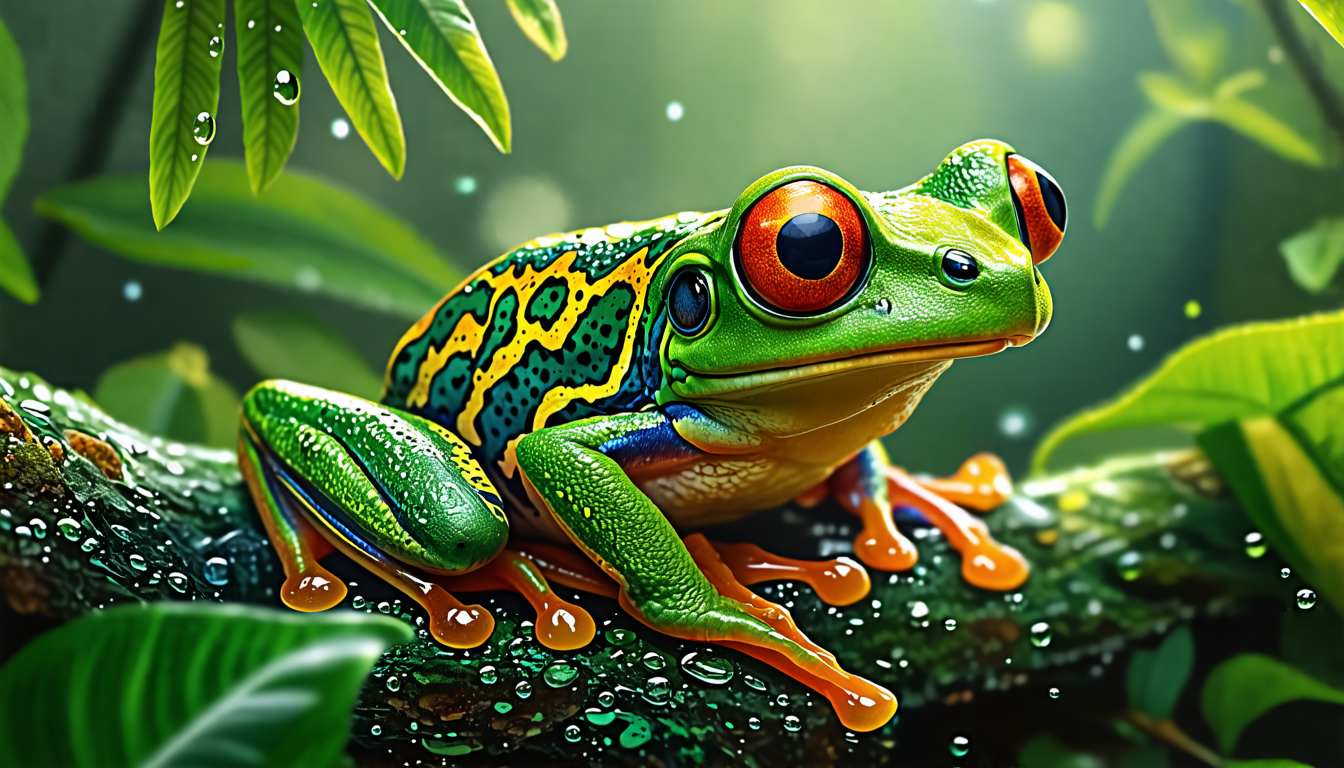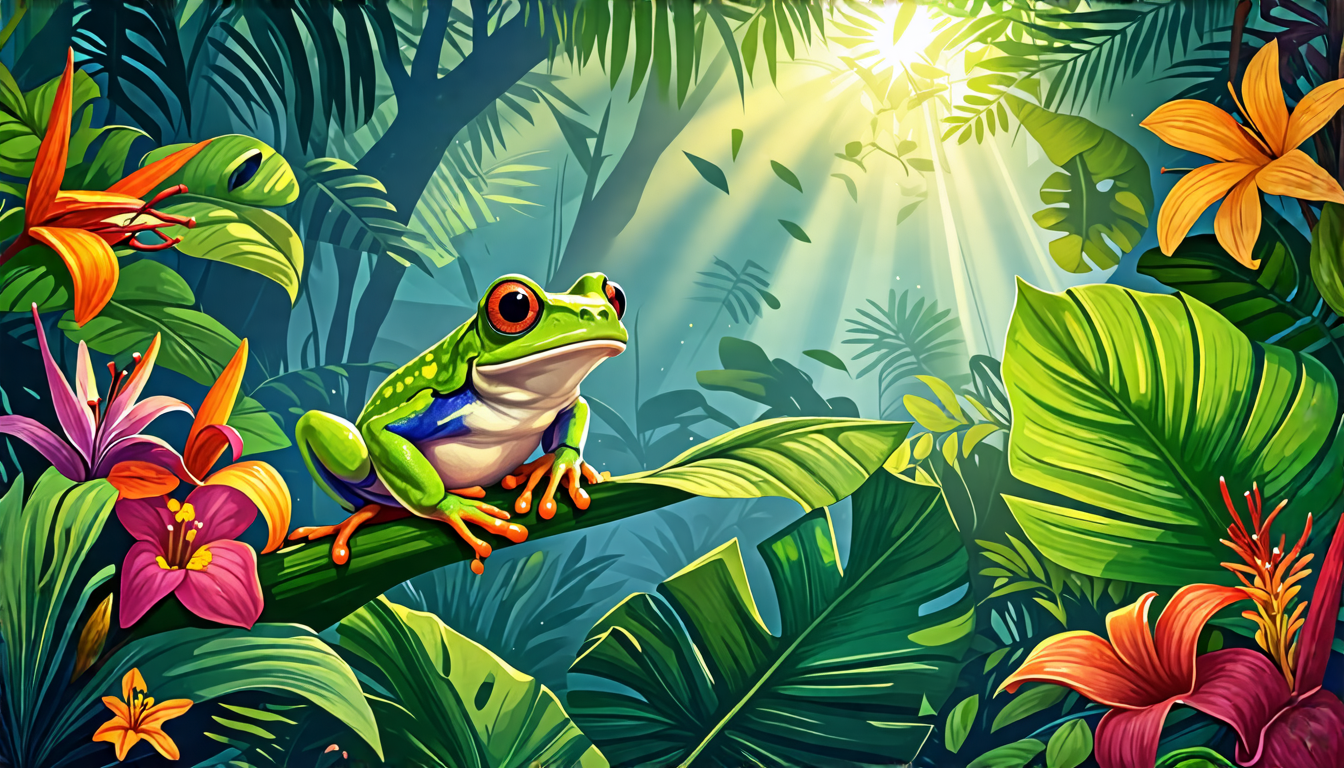
The Unique World of the White-Lipped Tree Frog
The world of amphibians is teeming with fascinating creatures, each with its unique charm and ecological significance. Among them, the White-lipped tree frog stands out as an extraordinary species that captivates both scientists and nature enthusiasts alike. Known for its distinct white lip and vibrant green coloration, this frog is more than just a visual delight; it’s an essential part of the ecosystem. Studying the White-lipped tree frog not only unveils the mysteries of its behavior and life cycle but also highlights its role in maintaining ecological balance.
Native to the tropical rainforests of Northern Australia and New Guinea, the White-lipped tree frog thrives in wet, humid environments. Its natural habitat includes lowland rainforests, swamps, and even suburban gardens. Understanding this frog’s habitat is crucial as it’s intricately linked to its survival and reproductive strategies. As we delve deeper into the characteristics and behaviors of the White-lipped tree frog, we uncover a wealth of knowledge that contributes to the broader field of herpetology and aids in conservation efforts.
With its notable physical traits and adaptive behaviors, the White-lipped tree frog draws attention to the beauty and complexity of amphibian life. From its life cycle and reproductive habits to its interactions within its habitat, this frog embodies the essence of evolutionary wonder. Addressing frequently asked questions and providing valuable insights into its conservation status further emphasizes the urgent need to protect this species.
As we embark on this journey to discover the unique world of the White-lipped tree frog, we invite you to explore its compelling story and the critical environmental importance it holds.
White-Lipped Tree Frog
Brief Overview of the Species
If you’ve ever marveled at vibrant rainforest dwellers, the White-lipped tree frog surely ranks high on your list. Scientifically known as Litoria infrafrenata, this stunning amphibian boasts some of the most striking appearances in the frog kingdom. Indigenous to the tropical regions of Australia, Papua New Guinea, and Indonesia, these frogs are an embodiment of the lush, verdant environments they inhabit.
Importance and Relevance of Studying the White-Lipped Tree Frog
Why focus on the White-lipped tree frog? Understanding and conserving this particular species is crucial for several reasons. Not only do these frogs serve as bioindicators, reflecting the health of their ecosystems, but they also play a fundamental role in the intricate web of predation and competition. Their study can unveil valuable insights into the broader trends of biodiversity and environmental health in tropical regions. Furthermore, researching these frogs can contribute to amphibian conservation worldwide, as they represent a link to understanding broader ecological impacts and threats.
General Characteristics and Habitat
White-lipped tree frogs are easily recognizable by their prominent white ‘lip’ marking that extends from their lower jaw to their forearms. Their skin usually gleams with a brilliant, leafy green that allows them to camouflage seamlessly into their surroundings. Typically inhabiting lowland rainforests, swampy areas, and even urban gardens, these frogs are extraordinarily adaptable. They prefer areas with high humidity and access to fresh water, including small ponds, streams, and pools.
| Key Facts About the White-Lipped Tree Frog | |
|---|---|
| Scientific Name | Litoria infrafrenata |
| Natural Habitat | Tropical rainforests of Australia, Papua New Guinea, and Indonesia |
| Key Physical Features | White ‘lip’ marking, bright green color, large size (up to 14 cm) |
| Diet | Insects, small invertebrates |
| Conservation Status | Least Concern |
Their highly adaptable nature is evident not only in their choice of habitat but in their astonishing adaptability to environmental changes. These frogs are mostly arboreal, spending a significant amount of their lives high in the tree canopies. However, they are known to descend to ground level, especially during the breeding season.
It’s clear that the White-lipped tree frog holds a special place in the ecosystem, acting as both predator and prey within its habitat. Whether you are an ecologist, a nature enthusiast, or someone curious about the natural world, uncovering the life of these remarkable amphibians offers a window into the dynamic balance of tropical ecosystems.

Physical Characteristics and Behavior
Detailed Description of the Frog’s Appearance
The White-lipped tree frog, scientifically known as Litoria infrafrenata, stands out with its remarkable physical attributes. This species is the largest tree frog in the world, measuring up to 14 centimeters in length. What really sets this frog apart is its distinctive white stripe running from the lower lip to the shoulder, giving it its name.
The coloration of the White-lipped tree frog can vary from bright green to a more subdued olive, allowing it to blend seamlessly into its lush habitat. Their smooth skin often has a slightly waxy appearance, which helps to prevent water loss—an essential adaptation for life in tropical environments. Furthermore, the frog’s large toe pads provide excellent grip, aiding its arboreal lifestyle.
Notable Behaviors and Adaptations
The behaviors and adaptations of the White-lipped tree frog are truly fascinating and testify to its evolutionary success.
- Arboreal Lifestyle: Primarily nocturnal, the White-lipped tree frog spends its nights hunting insects and other small prey. During the day, it can be found resting in tree canopies, using its excellent climbing abilities to navigate the forest.
- Vocal Communication: Males are known for their loud and distinctive calls, which play a crucial role in attracting mates and defending territory. These vocalizations can often be heard echoing through rainforests and are considered a true testament to the species’ unique communication methods.
- Crypsis and Color Change: Their ability to change coloration slightly allows them to adapt to different environments, aiding in camouflage from predators and efficiency in hunting.
A notable adaptation of the White-lipped tree frog is its capacity to secrete a mild toxin from its skin, which provides an additional layer of defense against potential threats. This adaptation is particularly advantageous given the diverse array of predators in its natural habitat.
Life Cycle and Reproductive Habits
Understanding the life cycle and reproductive habits of the White-lipped tree frog offers valuable insights into its survival strategies and ecological impact.
| Stage | Description |
|---|---|
| Egg | Frogs lay clusters of eggs in freshwater bodies, often attaching them to vegetation to provide a stable environment for development. |
| Tadpole | The eggs hatch into tadpoles, which are primarily herbivorous, feeding on algae and organic material in the water. This stage can last from a few weeks to several months, depending on environmental conditions. |
| Metamorphosis | During metamorphosis, tadpoles undergo significant physiological changes, developing limbs and losing their tails. This critical transition allows them to move from an aquatic to a terrestrial lifestyle. |
| Adult | Once fully metamorphosed, the frog continues its life on land and in trees. Adults begin the cycle anew by engaging in reproductive behaviors during the breeding season, which corresponds with the rainy season when water abundance is high. |
The breeding season of the White-lipped tree frog typically coincides with the beginning of the rainy season. Male frogs congregate in temporary pools formed by the rain, where they establish territories and call vigorously to attract females. Once a match is made, the female lays her eggs in the water, ensuring that the next generation of tadpoles will have a nurturing environment.
In summary, the White-lipped tree frog exhibits a range of physical characteristics and behaviors that not only captivate the interest of researchers and nature enthusiasts but also underscore the species’ adeptness at thriving in its environment. From its striking appearance to its unique behavioral traits, this species proves to be a fascinating subject for study and appreciation.

Conservation Status and Environmental Importance
Current Conservation Status of the White-Lipped Tree Frog
The conservation status of the White-lipped tree frog is a topic of growing concern among environmentalists. Classified as Least Concern by the International Union for Conservation of Nature (IUCN), this species is not currently at immediate risk of extinction. However, this classification can be misleading. The White-lipped tree frog faces several threats that could significantly impact its population in the near future.
Habitat loss is a primary concern. As human activities such as logging and agriculture expand, the natural habitats of these frogs diminish. Additionally, climate change poses a substantial threat, altering the delicate ecosystems these frogs depend on for survival. Increased global temperatures and changing precipitation patterns can lead to habitat degradation, affecting the availability of food and breeding sites.
In the past decade, there has been a noticeable decline in amphibian populations worldwide due to diseases such as chytridiomycosis, a fungal infection that affects amphibian skin. The White-lipped tree frog is not immune to this disease, and affected populations have been reported in certain areas.
Role in the Ecosystem and Environmental Significance
Understanding the environmental significance of the White-lipped tree frog is crucial for grasping why conservation efforts are essential. These frogs play a pivotal role in their ecosystems, acting as both predator and prey.
As predators, White-lipped tree frogs help control insect populations. They consume vast amounts of insects, including pests that can damage crops and spread diseases. This natural form of pest control is invaluable to both natural ecosystems and human agricultural areas.
Conversely, as prey, they are an important food source for a variety of animals, including birds, snakes, and small mammals. This interconnectedness illustrates their role in maintaining the balance within their ecosystems. A decline in their population could have a cascading effect, leading to imbalances that could affect numerous other species.
Moreover, their permeable skin makes them highly sensitive to environmental changes, acting as bioindicators for ecosystem health. The presence and health of White-lipped tree frog populations can provide valuable information about the state of their habitats, offering insights for broader environmental assessments and actions.
Efforts and Measures for the Protection and Preservation of the Species
Various efforts and measures are underway to protect and preserve the White-lipped tree frog. Conservation organizations and governmental agencies are actively working on multiple fronts to address the threats faced by this species.
1. Habitat Conservation: One of the most effective strategies is the protection of natural habitats. Establishing reserves and protected areas ensures that these frogs have safe and undisturbed environments to thrive in. In Australia and New Guinea, where these frogs are predominantly found, several protected areas have been designated to safeguard their habitats.
2. Disease Management: Research and monitoring programs aim to understand and manage diseases such as chytridiomycosis. Efforts include the development of treatments and the implementation of disease management protocols to mitigate the impacts on frog populations.
3. Climate Change Mitigation: Addressing the broader issue of climate change is crucial. Reducing carbon emissions and promoting sustainable practices can help mitigate the effects of climate change, ultimately benefiting the habitats of the White-lipped tree frog.
4. Public Awareness and Education: Engaging local communities through education and awareness campaigns fosters a sense of stewardship and encourages sustainable practices. Highlighting the importance of amphibians and their role in ecosystems can lead to community-based conservation efforts.
5. Research and Monitoring: Continuous research and monitoring are essential to track population trends and understand the health of frog populations. By studying their behaviors, breeding patterns, and environmental changes, scientists can devise more effective conservation strategies.
To illustrate the importance of conservation efforts, consider the success stories of other species. For instance, the conservation of the golden lion tamarin in Brazil, through similar integrated efforts, has led to a significant rebound in their populations. The same approach could prove beneficial for the White-lipped tree frog.
| Conservation Effort | Impact |
|---|---|
| Habitat Conservation | Protection of natural habitats, ensuring safe environments for breeding and living. |
| Disease Management | Mitigation of spread and impact of diseases such as chytridiomycosis. |
| Climate Change Mitigation | Reduction in adverse climatic effects on frog habitats. |
| Public Awareness and Education | Community engagement and sustainable practices promotion. |
| Research and Monitoring | Informed conservation strategies through ongoing studies and tracking. |
The future of the White-lipped tree frog hinges on the collective efforts of individuals and organizations dedicated to preserving our planet’s ecological balance. By supporting conservation initiatives and adopting sustainable practices, we can ensure this unique species continues to thrive for generations to come.
Conclusion
The White-lipped tree frog is not just an extraordinary example of amphibian diversity but also a crucial player in its ecosystem. By understanding the significant physical features and unique behaviors of this fascinating species, we gain valuable insights into the complex web of life that thrives in its natural habitat. The conservation status of the White-lipped tree frog is a stark reminder of the fragility of our environment and the urgent need to take tangible measures to protect biodiversity.
The concerted efforts for conservation and preservation are essential, as each species, including the White-lipped tree frog, plays an integral role in maintaining ecological balance. By continuing to study and protect these remarkable amphibians, we not only preserve the wonders of the natural world for future generations but also secure the health of our planet. Let us all commit to fostering a deeper appreciation and proactive approach towards the conservation of the White-lipped tree frog and the myriad of other species that share our world.
